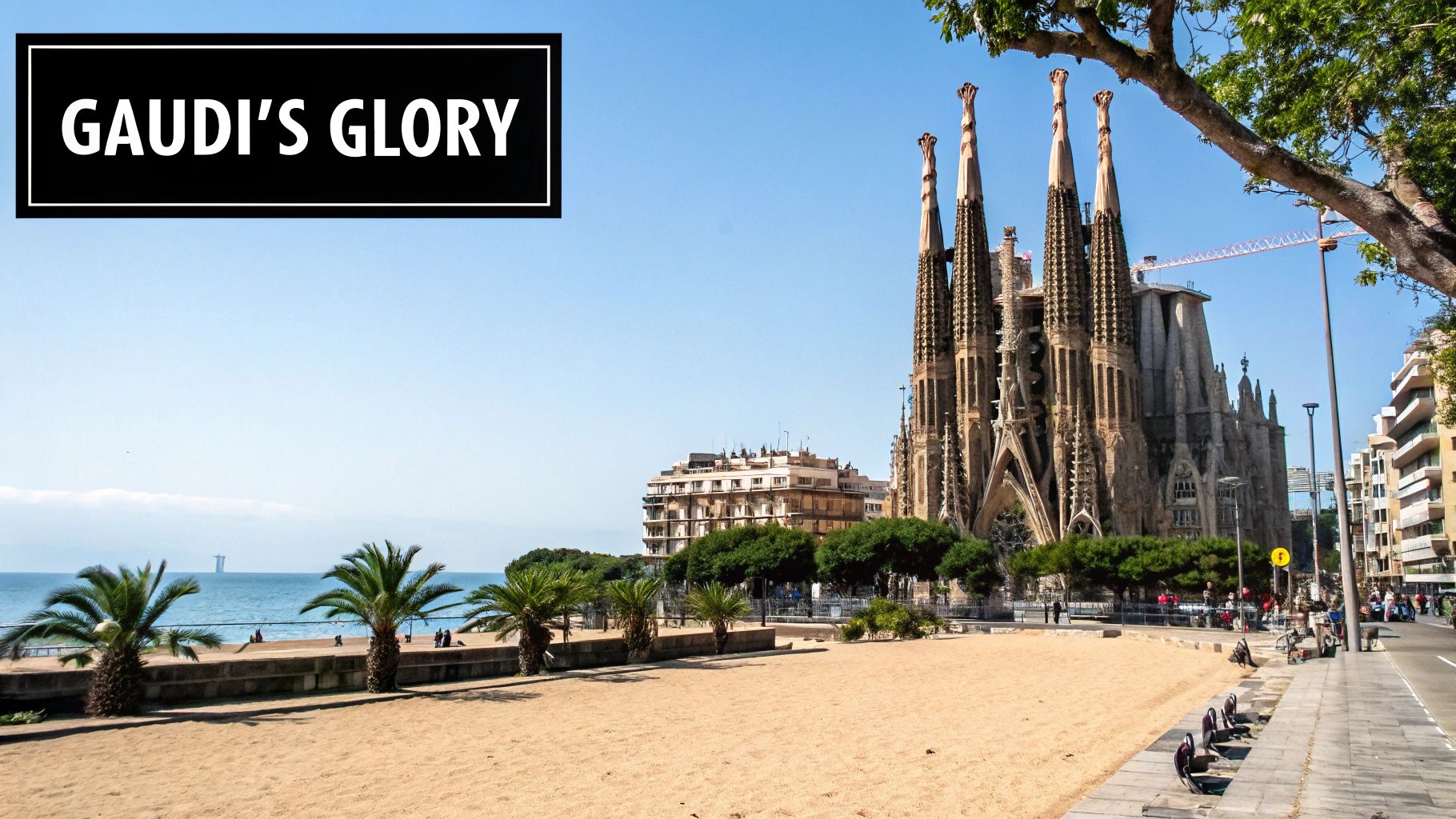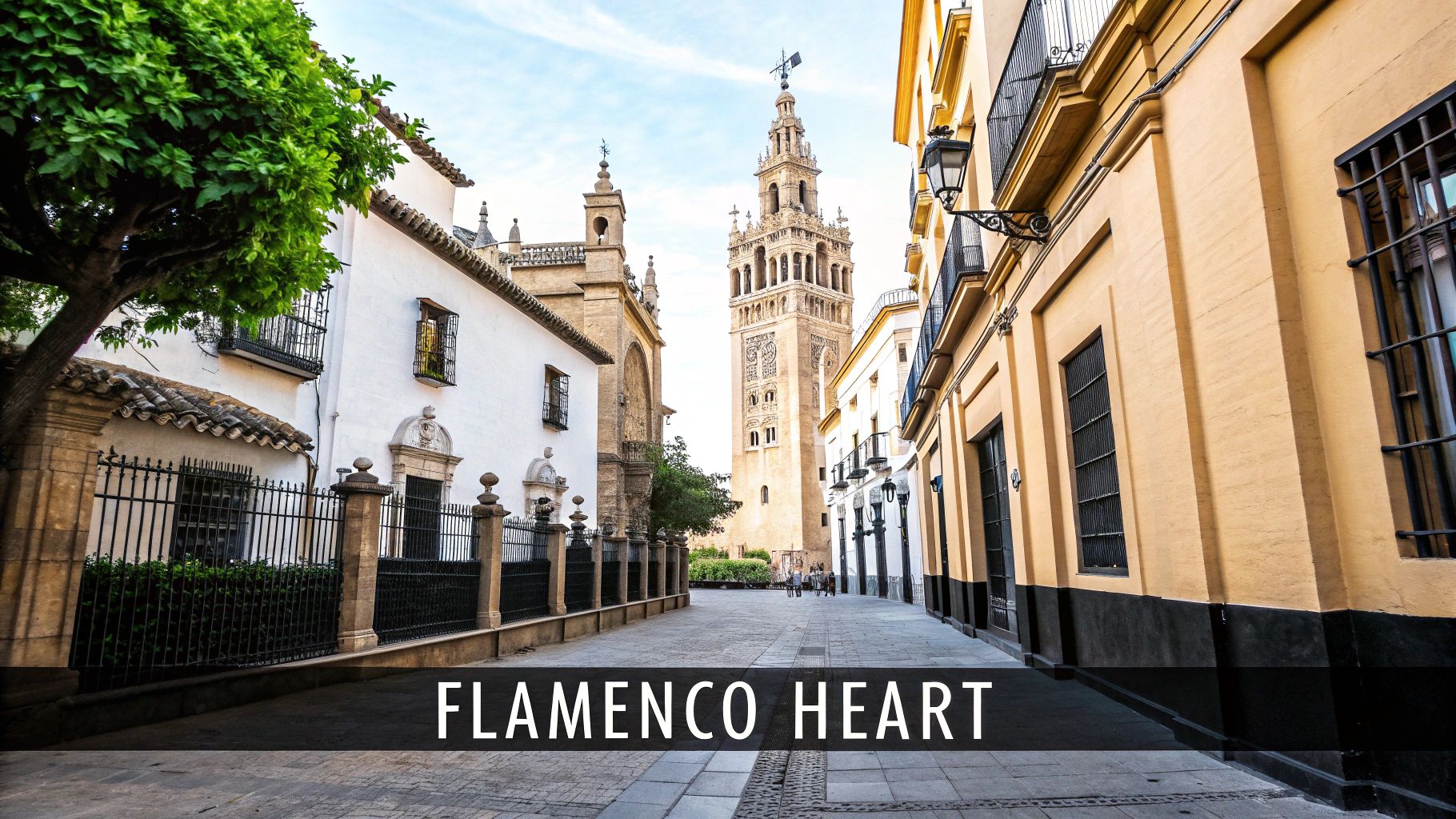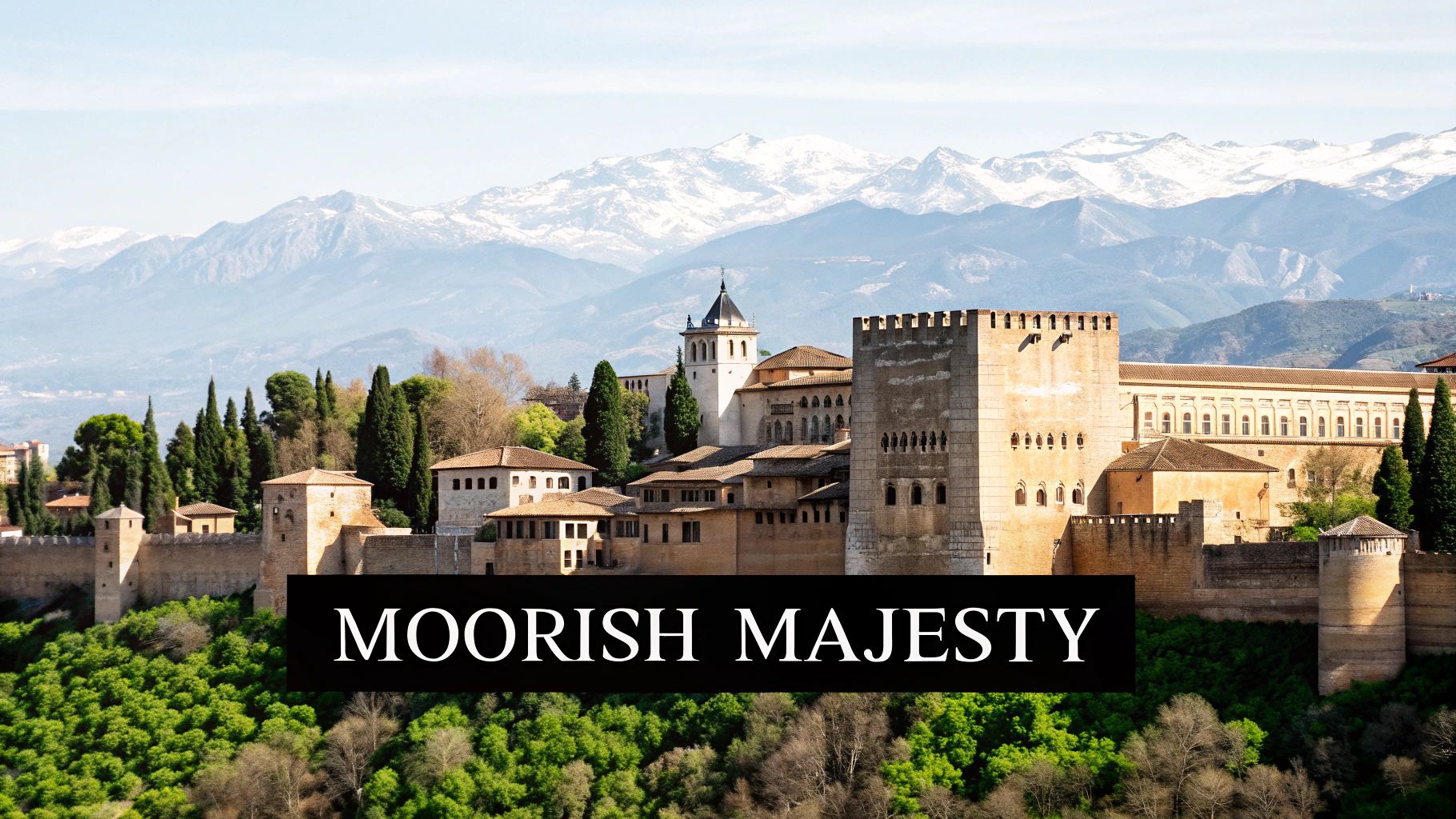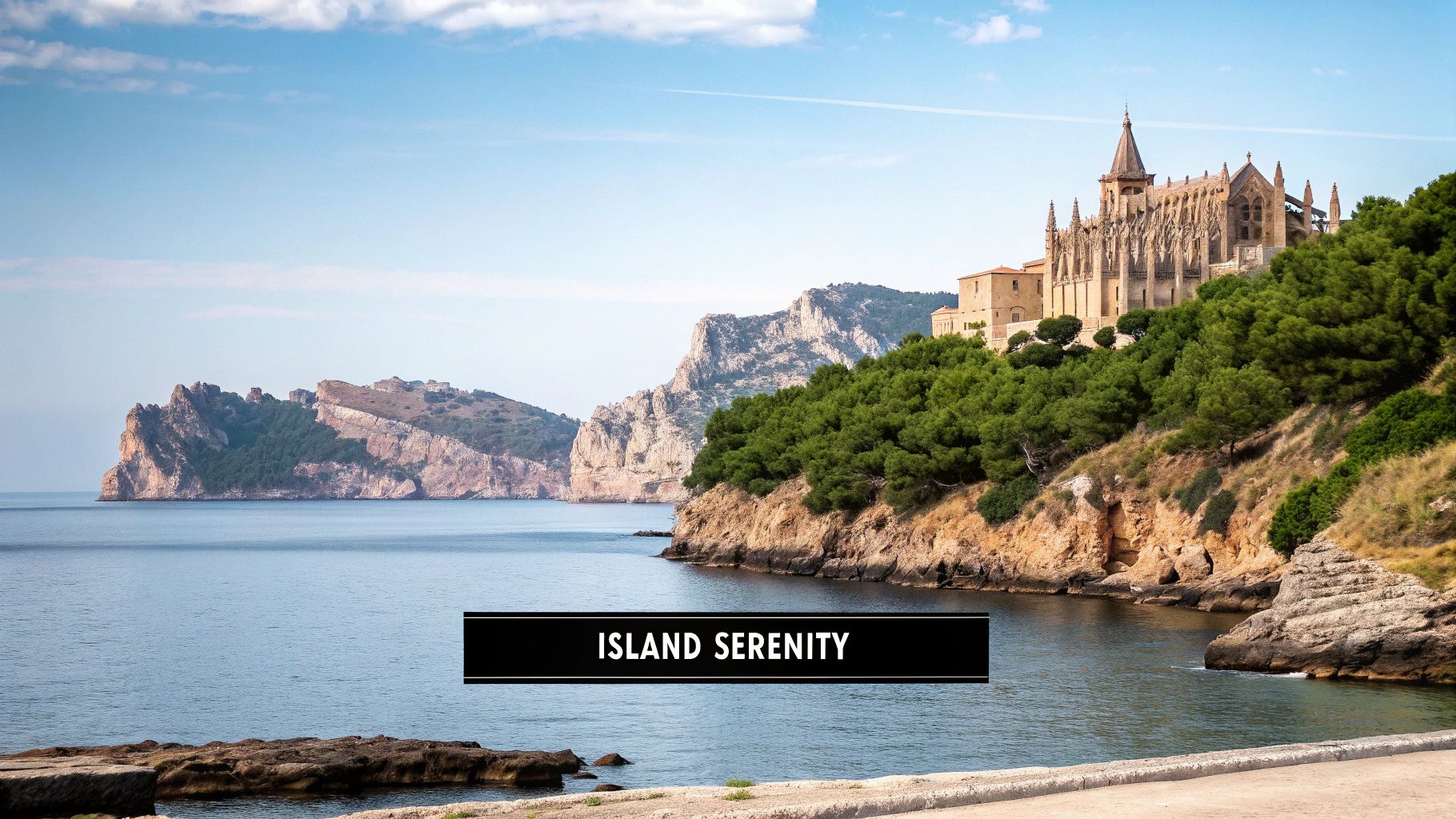¡Tu carrito actualmente está vacío!

10 Best Places to Visit in Spain
Planning Your Dream Trip to Spain? Start Here!
Ready to explore España? This list of the ten best places to visit in Spain will help you plan an unforgettable trip. From the vibrant streets of Barcelona to the historic charm of Toledo, we’ll cover the must-see spots for every traveler. Whether you crave bustling city life, tranquil beaches, or cultural immersion, this guide offers diverse destinations, each with its own unique flavor. Discover why these Spanish cities and regions are top travel destinations and start planning your Iberian adventure!
1. Barcelona
Barcelona, a dazzling jewel on the Mediterranean coast, earns its spot as one of the ten best places to visit in Spain, and arguably, the world. This cosmopolitan city effortlessly blends breathtaking architecture, a vibrant cultural scene, and the laid-back allure of beach life. If you’re searching for a destination that truly has it all, Barcelona should be at the top of your list. Think of it as a paella of experiences, perfectly seasoned with history, art, and a dash of Catalan flair.

Barcelona’s most iconic feature is undoubtedly the architectural genius of Antoni Gaudí. His whimsical and organic style is woven into the fabric of the city, most notably in the Sagrada Familia, a basilica that’s been under construction since 1882 and continues to inspire awe. This “ongoing masterpiece” is just the tip of the Gaudí iceberg; Park Güell, with its mosaic-covered benches and fantastical structures, and the undulating facades of Casa Batlló and Casa Milà (La Pedrera), further showcase his unique vision. Exploring these architectural wonders feels like stepping into a dream, a testament to human creativity and imagination.
Beyond Gaudí, Barcelona boasts a rich tapestry of historical and cultural attractions. Wander through the labyrinthine streets of the Gothic Quarter (Barri Gòtic), where medieval buildings whisper tales of the city’s past. Experience the vibrant energy of La Rambla, a pedestrian boulevard teeming with street performers, flower stalls, and lively cafes. For football fanatics, a pilgrimage to Camp Nou, the home of FC Barcelona, is a must. And when you need a break from the urban buzz, the golden sands of Barceloneta beach offer the perfect Mediterranean escape. Montjuïc hill provides panoramic views of the city, alongside Olympic facilities and cultural venues, making it a perfect spot for a leisurely afternoon. Learn more about Barcelona for deeper insights into its unique culture and language.
Pros:
- The perfect blend: Barcelona expertly balances urban exploration with beach relaxation, offering something for everyone.
- Architectural marvel: From Roman ruins to modernist masterpieces, the city is an architectural playground.
- Easy to navigate: Barcelona has an excellent public transportation system, making it easy to get around.
- Culinary delights: Indulge in a world-class culinary scene, from traditional tapas bars to bustling food markets like La Boqueria.
- Vibrant nightlife: Experience the city’s electric nightlife and immerse yourself in its numerous cultural festivals.
Cons:
- Crowds: Barcelona is a popular destination, and it gets extremely crowded, especially during the summer months.
- Pickpockets: Be vigilant with your belongings, particularly in touristy areas like Las Ramblas.
- Cost of living: Barcelona can be more expensive than other Spanish cities.
- Overtourism: The city is grappling with the challenges of overtourism, which can impact the local experience.
Tips for your Barcelona adventure:
- Book in advance: Secure your Sagrada Familia tickets well in advance, ideally several weeks before your visit.
- Utilize public transport: The metro is an efficient and affordable way to navigate the city.
- Shoulder seasons are best: Consider visiting during spring (April-June) or fall (September-October) for pleasant weather and fewer crowds.
- Learn some Catalan: While Spanish is widely spoken, learning a few basic Catalan phrases will enhance your experience and show respect for the local culture.
- Be aware of your surroundings: Stay vigilant with your belongings, especially in crowded areas, to avoid pickpocketing incidents.
Barcelona offers a truly unforgettable experience. Its unique blend of Catalan culture, stunning architecture, and vibrant atmosphere makes it a must-visit destination for any traveler seeking an authentic and exciting Spanish adventure. This city isn’t just a place to visit; it’s a place to savor.
2. Madrid
Madrid, the pulsating heart of Spain, earns its spot on our list of the ten best places to visit in Spain not just for being the capital, but for offering a truly authentic Castilian experience you won’t find anywhere else. Forget the beach for a moment (there isn’t one!), and dive headfirst into a city that seamlessly blends royal history with modern dynamism. Think world-class art, elegant boulevards buzzing with life, tantalizing tapas, and a nightlife scene that will leave you wondering if the sun ever actually rises.
Madrid is a city that demands to be explored. Wander through the sprawling 350-acre urban oasis that is Retiro Park, rent a rowboat on the lake, or simply relax and soak up the atmosphere. History buffs will be in their element exploring the opulent Royal Palace of Madrid (Palacio Real), standing in awe of the grandeur that once housed Spanish monarchs. And speaking of history, let’s not forget the iconic Plaza Mayor and Puerta del Sol, historic squares that have witnessed centuries of Spanish life unfold.
But Madrid isn’t just about the past. This city is alive with a vibrant contemporary culture. Gran Vía, the main shopping and entertainment street, pulsates with energy, offering a mix of high-street brands, dazzling theaters, and a plethora of dining options. Football fanatics will undoubtedly want to make a pilgrimage to the legendary Santiago Bernabéu Stadium, home of Real Madrid. And when the sun goes down, Madrid truly comes alive, showcasing its legendary nightlife with countless bars, clubs, and tapas joints spilling out onto the streets.
Of course, a trip to Madrid wouldn’t be complete without experiencing its artistic treasures. The Prado Museum is a must-see, housing one of the world’s finest art collections, including masterpieces by Spanish masters like Goya and Velázquez. Don’t stop there, though! Madrid boasts what’s known as the “Golden Triangle of Art,” which includes the Reina Sofía Museum (home to Picasso’s Guernica) and the Thyssen-Bornemisza Museum, completing a trifecta of artistic brilliance.
Pros:
- World-Class Art Museums: The “Golden Triangle of Art” is a cultural pilgrimage for art lovers worldwide.
- Central Location: Perfect for day trips to other historical gems like Toledo, Segovia, and Ávila.
- Excellent Public Transportation: Navigating the city is a breeze thanks to Madrid’s efficient metro and bus system.
- Lower Prices than Barcelona: Your travel budget will stretch a little further in Madrid.
- Authentic Spanish Culture and Cuisine: Experience the real deal, from traditional tapas to the lively “paseo” evening stroll.
Cons:
- Extreme Weather: Be prepared for scorching summers and chilly winters.
- Less Architectural Diversity than Barcelona: While beautiful, Madrid’s architecture might not be as varied as Barcelona’s.
- No Beaches or Coastal Attractions: If you’re craving sand and sea, Madrid might not be the ideal choice.
- Air Pollution: Like many large cities, air pollution can be an issue, especially during the hotter months.
Tips for your Madrid Adventure:
- Madrid Card: Score discounted entry to major attractions and free public transport.
- Free Museum Hours: Take advantage of free entry hours, typically in the late afternoons/evenings.
- Foodie Delights: Indulge in local specialties like cocido madrileño (chickpea stew) and bocadillo de calamares (squid sandwich – trust us, it’s delicious!).
- Neighborhood Vibes: Explore the vibrant neighborhoods of Malasaña and Chueca for a taste of local life.
- Embrace the Paseo: Join the locals for the evening “paseo,” a leisurely stroll through the streets.
So, if you’re looking for an authentic Spanish experience brimming with history, art, vibrant culture, and a buzzing nightlife, Madrid deserves a prominent place on your itinerary when exploring the ten best places to visit in Spain.
3. Seville
Seville (Sevilla), the vibrant capital of Andalusia, effortlessly earns its spot among the ten best places to visit in Spain. It’s the quintessential Southern Spanish experience, a place where flamenco rhythms echo through narrow medieval lanes, the scent of tapas hangs heavy in the air, and Moorish architecture whispers tales of a rich and layered past. This passionate city offers a heady mix of historical grandeur and modern buzz, ensuring there’s something to captivate every traveler. If you’re looking for an authentically Spanish adventure, Seville is calling your name!

Seville boasts not one, not two, but three UNESCO World Heritage Sites, a testament to its cultural significance. Prepare to be awestruck by the Seville Cathedral and its soaring La Giralda tower, the largest Gothic cathedral in the world. Wander through the breathtaking Real Alcázar, a royal palace complex showcasing spectacular Mudéjar architecture that will transport you to another era. And don’t miss the Plaza de España, a grand semi-circular plaza featuring regional pavilions, perfect for a leisurely stroll or a romantic gondola ride. Lose yourself in the labyrinthine streets of the Barrio Santa Cruz, the former Jewish quarter, with its hidden courtyards and flower-filled balconies. For a taste of the contemporary, check out the Metropol Parasol, a modern wooden structure affectionately known by locals as ‘Las Setas’ (the mushrooms).
Why Seville Deserves its Place in the Top Ten:
Seville offers a unique blend of old-world charm and modern energy. It’s more affordable than Madrid or Barcelona, allowing you to stretch your travel budget further while still experiencing the best of Spain. The tapas scene is exceptional, offering a delicious and affordable way to sample the local cuisine. And let’s not forget the warm, sunny climate, perfect for exploring the city’s many attractions. Whether you’re a history buff, a foodie, or simply seeking a vibrant and authentic cultural experience, Seville has something for everyone.
Pros:
- Authentic flamenco: Experience passionate flamenco performances in intimate venues, feeling the rhythm and soul of Andalusia.
- Incredible festivals: Witness the spectacular Holy Week (Semana Santa) and April Fair (Feria de Abril) celebrations, immersing yourself in the city’s vibrant traditions.
- Walkable historic center: Explore the charming streets and squares on foot, discovering hidden gems around every corner.
- More affordable: Enjoy a more budget-friendly trip compared to other major Spanish cities.
- Exceptional tapas: Indulge in a culinary adventure, sampling a wide variety of delicious tapas.
- Warm, sunny climate: Bask in the sunshine for most of the year, perfect for outdoor activities and exploring.
Cons:
- Scorching summers: Be prepared for extremely hot summers, with temperatures often exceeding 40°C (104°F).
- Limited public transport: Navigating the city can be challenging with limited public transportation options compared to larger cities.
- Crowds during festivals: Expect large crowds during peak festival seasons.
- Siesta closures: Many businesses close during afternoon siesta hours, so plan your activities accordingly.
Tips for the Savvy Traveler:
- Visit in spring: Experience the famous festivals and ideal weather.
- Try ‘tapeo’: Embrace the local custom of hopping from bar to bar, sampling different tapas.
- Book Alcázar tickets online: Avoid long lines by purchasing tickets in advance.
- Take a river cruise: Enjoy a unique perspective of the city from the Guadalquivir River.
- Sunscreen and indoor activities: Protect yourself from the midday summer heat with sunscreen and plan indoor activities.
Game of Thrones Fan? The Real Alcázar served as the filming location for the Water Gardens of Dorne, adding another layer of intrigue to this already fascinating site. So, if you’re a fan of the show, be sure to add Seville to your “ten best places to visit in Spain” list and relive the magic of Westeros.
4. Granada
Granada, a mesmerizing city nestled at the foot of the Sierra Nevada mountains in Andalusia, effortlessly earns its spot among the ten best places to visit in Spain. Here, Islamic and Spanish cultures intertwine, creating a unique atmosphere unlike anywhere else in Europe. Imagine strolling through ancient Moorish quarters, the scent of orange blossoms hanging heavy in the air, while the majestic Alhambra Palace watches over you from its hilltop perch. This is Granada, a city that captures the heart and soul of Spain’s vibrant past and present.

The city’s star attraction is undoubtedly the Alhambra, a breathtaking Moorish palace complex and UNESCO World Heritage site. This architectural masterpiece represents the pinnacle of Islamic art in Spain and offers a captivating glimpse into the opulent lifestyle of the Nasrid dynasty. But Granada is more than just the Alhambra. The charm of the Albaicín, the ancient Moorish quarter with its labyrinthine alleys and whitewashed houses, invites exploration. Lose yourself in its narrow streets, discover hidden plazas, and stumble upon breathtaking viewpoints overlooking the Alhambra. For a taste of authentic Romani heritage, venture into Sacromonte, a historic district famous for its cave dwellings and passionate flamenco performances. Learn more about Granada and plan your visit today.
Granada offers a sensory feast for every traveler. From the grandeur of the Granada Cathedral and Royal Chapel, showcasing stunning Renaissance architecture, to the scenic riverside walk along the Carrera del Darro, the city is packed with experiences waiting to be uncovered. The proximity to the Sierra Nevada mountains provides further opportunities for adventure, whether it’s hitting the ski slopes in winter or exploring the hiking trails in the warmer months.
One of the greatest joys of visiting Granada, especially for budget-conscious travelers, is the tradition of free tapas with drink orders in most bars – a custom unique to this city. Imagine enjoying a refreshing cerveza or a glass of local wine accompanied by a complimentary plate of delicious tapas. It’s a culinary adventure that won’t break the bank! Furthermore, Granada boasts a vibrant atmosphere fueled by its large student population, adding a youthful energy to the city’s cultural tapestry.
While Granada offers an unforgettable experience, it’s important to be aware of a few potential downsides. The hilly terrain can be challenging for some, and public transportation options are somewhat limited. Summers can be extremely hot, while winters can be surprisingly cold due to the city’s proximity to the mountains. And finally, due to its popularity, Alhambra tickets often sell out weeks, even months in advance.
Here are a few tips to make the most of your Granada adventure:
- Book Alhambra tickets well in advance (at least 3 months is recommended!). Don’t risk missing out on this iconic landmark.
- Visit the Mirador de San Nicolás at sunset for spectacular Alhambra views. The sight of the palace bathed in the golden light is truly magical.
- Experience authentic flamenco in the caves of Sacromonte. Let the passionate rhythms and soulful dances transport you.
- Use the mini-buses to navigate the hilly neighborhoods. Save your energy for exploring!
- Try local specialties like habas con jamón (broad beans with ham) and piononos (sweet pastries). Indulge in the flavors of Andalusia.
Popularized by Washington Irving’s “Tales of the Alhambra,” Granada continues to captivate visitors with its blend of history, culture, and natural beauty. This Andalusian gem undoubtedly deserves its place among the ten best places to visit in Spain, offering an unforgettable experience for any traveler seeking an authentic and enriching journey.
5. Valencia: Futuristic Flair Meets Ancient History
Valencia earns its spot among the ten best places to visit in Spain by offering a unique blend of cutting-edge architecture, historical charm, and sun-drenched Mediterranean beaches. Forget the hustle and bustle of Barcelona – Valencia serves up a similar vibe with a more relaxed pace and friendlier price tag. This vibrant coastal city, Spain’s third largest, has undergone a dramatic transformation from industrial hub to cultural powerhouse, making it a must-see for any traveler exploring Spain.
Valencia is perhaps best known as the birthplace of paella. Forget those tourist-trap seafood paellas – here, you’ll find the authentic paella valenciana, featuring rabbit and chicken, a culinary experience that alone justifies a trip to this incredible city. But beyond the delectable cuisine, Valencia offers a feast for the eyes and the soul.
The City of Arts and Sciences, designed by the renowned architect Santiago Calatrava, is an architectural marvel that looks like something straight out of a sci-fi film. Its futuristic buildings house an opera house, science museum, oceanographic park, and more, offering a fascinating glimpse into the world of art, science, and culture.
But Valencia isn’t just about looking forward; it also cherishes its rich past. Explore the historic center, a labyrinth of narrow streets leading to treasures like the Valencia Cathedral, rumored to house the Holy Grail, the magnificent La Lonja silk exchange, and the bustling Central Market, overflowing with fresh produce and local delicacies.
Need a break from the urban buzz? The Turia Gardens, a lush 9km park built in a former riverbed, provides a tranquil oasis right in the heart of the city. Or, soak up the Mediterranean sun on the beautiful Malvarrosa and Las Arenas beaches. For a taste of nature, venture out to the Albufera Natural Park, a stunning wetland area known for its rice paddies and diverse birdlife. Animal lovers shouldn’t miss the Bioparc Valencia, an innovative zoo offering an immersive experience that brings you face-to-face with incredible wildlife.
Why Valencia deserves its place in the top ten:
- Perfect Balance: Valencia offers the perfect trifecta: beach relaxation, urban exploration, and cultural immersion, all in one dynamic city.
- Foodie Paradise: Savor the authentic paella valenciana and other culinary delights in a city renowned for its gastronomy.
- Architectural Wonders: From the futuristic City of Arts and Sciences to the historic city center, Valencia offers a feast for the eyes.
- Sunshine and Smiles: With over 300 days of sunshine a year, Valencia offers a welcoming climate perfect for exploring.
Pros:
- Affordable: Less crowded and more budget-friendly than Barcelona.
- Excellent Climate: Bask in the Mediterranean sun year-round.
- Cycling Friendly: Flat terrain and a bike-sharing system make exploring a breeze.
- Good Public Transport: Easy to navigate the city.
Cons:
- Fewer International Flights: May require connecting flights.
- Siesta Time: Many shops and restaurants close during siesta hours.
- Las Fallas Crowds: The city gets incredibly crowded and expensive during the festival.
- Limited English: Less English spoken than in more touristy areas.
Tips for the Savvy Traveler:
- Paella Perfection: Don’t settle for seafood paella – try the authentic Valencian version with rabbit and chicken.
- Fallas Frenzy: Book accommodations well in advance if visiting during Las Fallas (mid-March).
- Bike Bliss: Utilize the Valenbisi bike-sharing system to explore the city.
- Sunset Spectacle: Witness a breathtaking sunset over the Albufera lagoon.
- Sweet Treat: Indulge in horchata with fartons, a local sweet drink and pastry combination.
Valencia truly offers something for everyone, making it a worthy contender among the ten best places to visit in Spain. So, ditch the overcrowded tourist traps and discover the magic of this vibrant Mediterranean gem. You won’t regret it!
6. San Sebastián
San Sebastián (or Donostia, if you’re feeling Basque) effortlessly earns its spot among the ten best places to visit in Spain, and let me tell you, it’s not just for the postcard-perfect La Concha Bay (though that definitely helps). This sophisticated coastal gem in Spain’s Basque Country is a feast for the senses, especially if you’re a foodie. Prepare your palate, because San Sebastián is ready to tantalize it with one of the highest concentrations of Michelin-starred restaurants per capita in the world. Yes, you read that correctly. Gastronomic paradise found.
But hold your horses, gourmand! San Sebastián isn’t just about fancy dining. This city offers a captivating blend of elegant Belle Époque architecture, a vibrant cultural scene deeply rooted in Basque traditions, and enough natural beauty to make you question why you’d ever leave. Imagine strolling along the golden sands of La Concha, frequently cited as one of Europe’s finest urban beaches, before diving headfirst (not literally, unless you’re a brave soul) into the lively pintxos bars of the Parte Vieja (Old Town). It’s a city where you can surf the waves at Zurriola Beach in the morning and savor world-class cuisine in the evening. Talk about a balanced diet!
A Symphony of Flavors and Sights:
San Sebastián offers a smorgasbord of experiences:
- La Concha Bay and Beach: Bask in the sun on this iconic crescent-shaped beach, consistently ranked among Europe’s best.
- Monte Igueldo: Ascend via funicular for breathtaking panoramic views of the bay and city. Trust me, it’s Instagram gold.
- Parte Vieja (Old Town): This is where the pintxos magic happens. Embark on a “pintxos crawl,” hopping from bar to bar, sampling delectable bite-sized snacks and local drinks.
- Kursaal Congress Centre: A modern architectural marvel that adds a touch of futuristic flair to the cityscape.
- San Telmo Museum: Immerse yourself in Basque culture and history at this fascinating museum.
- Three Urban Beaches: Take your pick! La Concha, Ondarreta, and Zurriola each offer a unique vibe.
The Good, the Bad, and the Delicious:
Pros:
- Gastronomy Galore: From humble pintxos bars to Michelin-starred establishments, your taste buds are in for a treat.
- Architectural Harmony: The city seamlessly blends beautiful architecture with stunning natural landscapes.
- Walkability: Explore the clean, safe, and easily walkable city center.
- Basque Culture: Experience the unique and vibrant Basque culture, which sets San Sebastián apart from other Spanish cities.
- International Film Festival (September): Rub shoulders with celebrities and film enthusiasts during this prestigious event.
- Surfing Hotspot: Catch some waves at Zurriola Beach.
Cons:
- Pricey Paradise: Be prepared to splurge, as San Sebastián is one of Spain’s most expensive cities.
- Rainy Days: Pack an umbrella, as it’s also one of the wettest cities in Spain.
- Limited Flights: Getting there might require a bit more planning compared to major Spanish cities.
- Summer Crowds: The city can get extremely crowded during the peak summer months.
Tips for the Savvy Traveler:
- Pintxos Crawl Like a Pro: Embrace the local tradition of hopping between pintxos bars in the Old Town, savoring one or two pintxos and a drink at each stop.
- Reservations are Key: Book restaurant reservations well in advance, especially for those coveted Michelin-starred experiences.
- Learn Some Basque: Impress the locals by learning a few basic Basque greetings. It’s not just Spanish here!
- Film Festival Fun: If you’re a cinephile, consider visiting during the International Film Festival in September.
- Monte Igueldo Views: Don’t miss the spectacular views from Monte Igueldo. The funicular ride up is an experience in itself.
Popularized By:
Celebrity chefs like Juan Mari Arzak and Pedro Subijana have put San Sebastián on the culinary map. Even Ernest Hemingway was a fan, frequently visiting and mentioning the city in his works.
So, if you’re searching for a city that seamlessly blends culinary excellence, natural beauty, and cultural richness, look no further than San Sebastián. It’s undoubtedly one of the ten best places to visit in Spain, and an experience that will leave you craving more.
7. Córdoba
Córdoba, a captivating jewel nestled in the heart of Andalusia, earns its spot among the ten best places to visit in Spain for its unique blend of cultures and its breathtaking historical legacy. Once the capital of Islamic Spain and a beacon of intellectual and artistic advancement, Córdoba offers a journey back in time to a period of remarkable coexistence and prosperity. If you’re looking for an experience richer than just ticking off tourist boxes, then Córdoba deserves a prominent place on your Spanish itinerary.
This mid-sized city provides a welcome respite from the hustle and bustle of larger Spanish destinations like Seville or Granada, allowing you to immerse yourself in its captivating atmosphere at a more relaxed pace. Its historic center, a UNESCO World Heritage Site, is remarkably walkable, allowing you to wander through a maze of narrow cobblestone streets, discovering hidden plazas and charming cafes around every corner. Plus, your travel budget will thank you – Córdoba offers a more affordable experience than many of Spain’s larger cities.
The undisputed crown jewel of Córdoba is the Mezquita-Catedral. This breathtaking edifice, a former mosque later converted into a cathedral, stands as a powerful symbol of the region’s complex religious history. Its iconic forest of red and white arches is a truly awe-inspiring sight. Learn more about Córdoba to delve deeper into the fascinating history of this architectural marvel.
But Córdoba is much more than just the Mezquita. The Judería, the historic Jewish quarter, with its narrow winding lanes and beautifully preserved synagogue, offers a glimpse into the vibrant Jewish community that once thrived here. Cross the majestic Roman Bridge spanning the Guadalquivir River, explore the Alcázar de los Reyes Cristianos, a medieval fortress with stunning gardens, and lose yourself in the charm of the Patios of Córdoba, traditional courtyards overflowing with colorful flowers. For a taste of ancient grandeur, venture just outside the city to Medina Azahara, the archaeological site of a former palatine city, a testament to the city’s powerful past.
Pros:
- Less crowded than Seville or Granada
- Walkable historic center
- More affordable than larger Spanish cities
- Unique fusion of Islamic, Jewish, and Christian heritage
- Famous Festival of the Patios in May
- Easy day trip from Seville
Cons:
- Extremely hot summers (often Spain’s hottest city)
- Smaller than other Andalusian destinations with fewer overall attractions
- Limited nightlife compared to larger cities
- Many attractions close during midday
Experiences You Won’t Want to Miss:
- Festival of the Patios (early May): Witness the city come alive with color as residents open their stunning flower-filled courtyards to the public.
- Córdoba Fair (late May): Immerse yourself in the vibrant Andalusian culture with flamenco dancing, equestrian displays, and traditional costumes.
Tips for Your Visit:
- Visit the Mezquita early in the morning to beat the crowds.
- Plan a visit during May to experience the spectacular Patio Festival.
- Indulge in local culinary delights like salmorejo (cold tomato soup) and flamenquín (fried pork roll).
- Consider using Córdoba as a base to explore other parts of Andalusia.
- If time is limited, a day trip from Seville is a viable option, but staying longer allows you to fully appreciate the city’s charm.
Córdoba offers a unique perspective on Spain’s rich history and cultural tapestry, making it a truly unforgettable destination among the ten best places to visit in Spain. So, step off the beaten path and discover the magic of this enchanting Andalusian city.
8. Bilbao: From Industrial Grit to Avant-Garde Glamour
Bilbao, you sleek, sophisticated surprise! While Barcelona and Madrid hog the Spanish spotlight, Bilbao quietly reinvented itself, trading gritty docks for dazzling museums and Michelin-starred meals. This Basque Country gem deserves a prominent spot on any “ten best places to visit in Spain” list, offering a unique blend of industrial heritage, cutting-edge architecture, and a vibrant cultural scene you won’t find anywhere else. Forget the clichés of sunny Spain; Bilbao embraces its drizzle and delivers an experience as refreshing as a dip in the Bay of Biscay.
Once a bustling industrial port city, Bilbao underwent a dramatic transformation, becoming a poster child for urban regeneration – a phenomenon so impactful it spawned the term “The Bilbao Effect.” The arrival of Frank Gehry’s titanium-clad Guggenheim Museum in 1997 was the catalyst, catapulting the city onto the international stage. This architectural marvel isn’t just a museum; it’s a shimmering symbol of Bilbao’s rebirth, drawing visitors from around the globe.
But Bilbao is more than just a pretty (metallic) face. Delve into the heart of the city, the Casco Viejo (Old Town), and wander the “Seven Streets,” a medieval labyrinth brimming with pintxo bars, boutiques, and the vibrant energy of Basque life. Foodies, rejoice! Bilbao is a gastronomic paradise, especially for those who appreciate the art of pintxos, the Basque version of tapas. And don’t miss the Ribera Market, Europe’s largest covered market, a feast for the senses and a great place to sample local delicacies.
Beyond the Guggenheim, art aficionados will find a treasure trove of masterpieces at the Fine Arts Museum (Museo de Bellas Artes), showcasing Basque and Spanish art. For a taste of contemporary cool, head to the Azkuna Zentroa, a stunning cultural center designed by Philippe Starck, housed in a former wine warehouse. And for a touch of industrial history, take a ride across the Vizcaya Bridge, a UNESCO World Heritage-listed transporter bridge that’s as functional as it is fascinating.
Why Bilbao deserves its place in the top ten:
- Less touristy than other Spanish hotspots: Escape the crowds and experience a more authentic slice of Spanish life.
- Gastronomic greatness: Prepare to be wowed by the Basque cuisine and the pintxo culture.
- Architectural eye candy: From Gehry’s Guggenheim to the historic Casco Viejo, Bilbao is a visual feast.
- Efficient and stylish transport: Navigate the city with ease on the Norman Foster-designed metro system.
- Gateway to Basque Country: Explore the stunning coastline and countryside surrounding Bilbao.
- Unique cultural identity: Immerse yourself in the Basque language and traditions.
Pros:
- Excellent gastronomy, particularly pintxos and Basque cuisine
- Impressive modern architecture alongside historic buildings
- Efficient metro system designed by Norman Foster
- Proximity to beautiful Basque countryside and coast
- Strong cultural identity with unique Basque language and traditions
Cons:
- Rainy climate (one of Spain’s wettest cities) – pack an umbrella!
- Industrial past means some areas still lack charm
- Fewer historical monuments than other Spanish cities
- Language barrier may be more pronounced with Basque being widely spoken – learn a few basic phrases!
Tips for Bilbao Bliss:
- Bilbao Card: Free public transport and museum discounts – a must-have!
- Pintxo pilgrimage: Plaza Nueva in the Old Town is pintxo central.
- Coastal excursions: Explore nearby towns like Getxo and the dramatic San Juan de Gaztelugatxe (Dragonstone in Game of Thrones).
- Panoramic perfection: Take the funicular to Mount Artxanda for breathtaking city views.
- Basque basics: Learn a few phrases like “kaixo” (hello) and “eskerrik asko” (thank you) to connect with the locals.
Bilbao isn’t just a city; it’s an experience. It’s a testament to the power of reinvention, a blend of old and new, grit and glamour. So, ditch the predictable and discover the magic of Bilbao – you won’t regret it!
9. Toledo: A Medieval Masterpiece Amongst the Ten Best Places to Visit in Spain
Prepare to be transported back in time in Toledo, a remarkably preserved medieval city perched dramatically on a hillside overlooking the winding Tagus River. Situated just 70km south of Madrid, Toledo earns its spot among the ten best places to visit in Spain for its mesmerizing blend of history, architecture, and culture. This isn’t just another dusty old town; it’s a vibrant tapestry woven from the threads of three major religions. Known as the “City of Three Cultures,” Toledo was a unique melting pot where Christians, Muslims, and Jews coexisted (relatively) peacefully for centuries, each leaving an indelible mark on the city’s character. Think cobbled lanes whispering tales of bygone eras, imposing fortresses guarding ancient secrets, and magnificent cathedrals reaching for the heavens.

Declared a UNESCO World Heritage site in 1986, exploring Toledo feels like stepping into a living museum. Wander through its labyrinthine medieval streets, marvel at the imposing Alcázar fortress, and be awestruck by the grandeur of the Toledo Cathedral, one of Spain’s most impressive Gothic masterpieces. The synagogues of Santa María la Blanca and El Tránsito offer glimpses into the city’s rich Jewish heritage, while the Monastery of San Juan de los Reyes stands as a testament to its Catholic monarchs. Art aficionados shouldn’t miss the Museum of El Greco, dedicated to the legendary painter who made Toledo his home and immortalized its landscapes and people in his iconic works. Even the city walls and gates, like the magnificent Puerta de Bisagra, exude history and charm.
Why Toledo Deserves a Place on Your Spanish Itinerary:
Toledo isn’t just a pretty face; it offers a unique and immersive historical experience you won’t find anywhere else. From its incredibly well-preserved medieval architecture and rich multicultural heritage to its fame for traditional crafts like damascene metalwork and mouthwatering marzipan, Toledo has something to captivate every traveler. The panoramic views from various viewpoints across the city are nothing short of breathtaking, offering stunning vistas of the cityscape and surrounding countryside. Plus, its proximity to Madrid makes it an ideal and easy day trip. While other Spanish cities might boast bustling nightlife, Toledo offers a different kind of magic – a chance to connect with the past and experience the soul of Spain in a truly authentic way.
Pros:
- Incredibly well-preserved medieval architecture
- Rich multicultural heritage
- Famous for traditional crafts, especially damascene metalwork and marzipan
- Spectacular panoramic views
- Easy day trip from Madrid
- Less crowded than major Spanish cities (except during peak day-trip hours)
Cons:
- Hilly terrain and steep streets (wear comfortable shoes!)
- Can get crowded with day-trippers during peak hours
- Limited nightlife (unless you count conversing with the ghosts of Spanish royalty)
- Extreme temperatures (scorching summers, chilly winters)
- Touristy vibes in the main areas
Toledo Travel Tips for the Savvy Explorer:
- Stay overnight: Experience the magic of Toledo after the day-trippers have departed.
- Mirador del Valle: Catch the best panoramic views of the city from across the river at this must-visit viewpoint.
- Foodie Adventures: Indulge in local specialties like marzipan and carcamusas (a hearty meat stew).
- Souvenir Shopping: Bring home a piece of Toledo’s history with authentic Toledo steel or damascene souvenirs.
- Comfortable Footwear: Cobbled streets and hills demand sturdy and comfortable shoes.
- Escalators: Utilize the escalators from the parking areas for an easier ascent to the old town.
Toledo has been immortalized by the likes of El Greco, whose masterpieces were inspired by the city’s beauty, and Cervantes, who even mentioned Toledo in his epic novel, Don Quixote. So, ditch the guidebook, lose yourself in the maze of history, and discover why Toledo is a true gem among the ten best places to visit in Spain.
10. Mallorca: Where Mountains Meet the Med
Mallorca (or Majorca), the largest of Spain’s Balearic Islands, earns its spot among the ten best places to visit in Spain thanks to its intoxicating blend of sun-drenched beaches, rugged mountain scenery, and a vibrant cultural scene. Forget the sangria-soaked stereotypes; this island paradise offers so much more than just mass tourism. While millions flock to its shores for guaranteed sunshine, Mallorca has wisely cultivated its appeal beyond the beach towel, showcasing its dramatic Serra de Tramuntana mountains (a UNESCO World Heritage site), charming villages, tantalizing gastronomy, and the historically rich capital of Palma.
Imagine yourself wandering through Palma’s medieval streets, the magnificent Gothic cathedral dominating the skyline. Then picture yourself hiking through fragrant pine forests in the Serra de Tramuntana, stumbling upon picturesque villages like Valldemossa and Deià – havens for artists and writers for centuries. And of course, no trip to Mallorca is complete without basking on one of its stunning beaches and coves (or calas as the locals call them). From the turquoise waters of Cala Formentor to the pristine white sands of Es Trenc, there’s a perfect beach for every sun worshipper.
Beyond the Beach:
Mallorca offers a feast for the senses beyond the beach. Explore the dramatic Cap de Formentor peninsula with its sheer cliffs and iconic lighthouse, delve into the magical Cuevas del Drach (Dragon Caves) with their subterranean lake, and discover traditional rural estates (possessions) surrounded by ancient olive groves. Feeling adventurous? Cycle through the challenging mountain roads or hike through the stunning landscapes. Foodies will rejoice in the island’s rich culinary traditions, from the flaky, spiral-shaped ensaïmada pastries to the spicy sobrasada sausage. Don’t forget to try the simple yet delicious pa amb oli (bread with olive oil, tomato, and various toppings) – a true taste of Mallorca.
The Good, the Bad, and the Beautiful:
Pros:
- Excellent accessibility: Palma’s international airport makes getting here a breeze.
- Diverse landscapes: Mountains, beaches, and everything in between.
- Year-round mild climate: Sunshine almost guaranteed!
- Culinary delights: Indulge in the island’s rich gastronomic offerings.
- Outdoor adventures: Explore well-developed cycling and hiking routes.
- Rich cultural heritage: Discover a world beyond the beach resorts.
Cons:
- Overcrowding in summer: Popular beaches can get packed.
- Mass tourism hotspots: Certain areas (Magaluf, s’Arenal) cater primarily to package holidays.
- Peak season prices: Expect higher prices during the summer months.
- Summer traffic: Coastal roads can get congested.
- Environmental concerns: Overtourism poses a challenge to the island’s delicate ecosystem.
Insider Tips for the Savvy Traveller:
- Shoulder seasons are best: Visit in May-June or September-October for pleasant weather and fewer crowds.
- Rent a car: Explore the island at your own pace and discover hidden gems.
- Try the local specialties: Don’t miss out on pa amb oli, ensaïmada, and sobrasada.
- Take the vintage train: Enjoy a scenic journey from Palma to Sóller on a charming wooden train.
- Sunday market in Pollença: Browse local crafts and produce.
- Explore the lesser-known regions: Venture into the central and eastern parts of the island for a more authentic experience.
Famous Footprints:
Mallorca has attracted artists, writers, and celebrities for centuries. Frédéric Chopin and George Sand famously spent a winter in Valldemossa, while poet Robert Graves made Deià his home. Tennis superstar Rafael Nadal, a native of Manacor, also adds to the island’s star power, and the Spanish royal family frequently holidays here.
Mallorca truly deserves its place among the ten best places to visit in Spain. It offers a captivating blend of natural beauty, cultural richness, and vibrant energy, providing a truly unforgettable Mediterranean experience. So, ditch the mainland and discover the magic of Mallorca!
10-Point Comparison: Spains Best Destinations
| Destination | 🔄 Complexity | ⚡ Resources | 📊 Outcomes | 💡 Use Cases | ⭐ Advantages |
|---|---|---|---|---|---|
| Barcelona | Moderate planning amid busy tourist zones | Higher costs; advanced bookings required | Rich cultural, architectural, and beach experiences | Urban culture with seaside relaxation | Iconic Gaudí masterpieces and vibrant nightlife |
| Madrid | Easy navigation with efficient transport | Moderate expenses; excellent connectivity | World-class museums and dynamic urban life | Ideal for art lovers and day trips | Authentic Spanish history and impressive landmarks |
| Seville | Requires careful planning around festivals and siestas | Affordable with seasonal planning considerations | Immersive encounters with flamenco and Moorish heritage | Perfect for cultural and festival exploration | Authentic Andalusian atmosphere and historic sites |
| Granada | High booking effort for major sites (e.g., Alhambra) | Budget-friendly yet requires early reservations | Unique blend of Islamic and Spanish influences | Great for history buffs and cultural tours | Awe-inspiring Alhambra and complimentary tapas culture |
| Valencia | Moderate planning (consider festival timings like Las Fallas) | Cost-effective with diverse urban offerings | Balanced mix of modern art, historic treasures, and beach life | Suitable for family trips and urban escapes | Birthplace of paella and futuristic architectural gems |
| San Sebastián | Requires reserved dining and weather-based planning | Premium costs; gourmet-focused spending | Exceptional culinary scene with scenic coastal views | Ideal for food enthusiasts and luxury getaways | High concentration of Michelin-starred restaurants and elegant beaches |
| Córdoba | Low complexity with a walkable historic center | Budget-friendly with seasonal midday closures | Intimate historical setting with multicultural landmarks | Perfect for short cultural excursions | Unique Mezquita and charming patio festivals |
| Bilbao | Moderate urban navigation with modern transit | Moderate budget; efficient public systems | Urban regeneration showcased through modern art and culture | Best for art and architectural tourism | Guggenheim Museum and authentic Basque cuisine |
| Toledo | Moderate planning due to crowded medieval streets | Budget-conscious with hilly terrain challenges | Deep immersion into medieval and multicultural heritage | Suitable for historical and cultural short stays | Well-preserved architecture and panoramic city views |
| Mallorca | High planning demand during peak tourism seasons | Varies widely; premium costs in peak season | Diverse landscapes merging beaches, mountains, and historic sites | Ideal for island escapes and nature lovers | Scenic diversity from coastal resorts to rural villages |
Ready to Explore the Best of Spain?
From the architectural wonders of Barcelona and Bilbao to the historic charm of Toledo and Córdoba, the ten best places to visit in Spain offer a truly unforgettable experience. Whether you’re captivated by the flamenco rhythms of Seville, the Moorish palaces of Granada, or the sun-kissed beaches of Mallorca, this diverse country has something to ignite every traveler’s passion. We’ve journeyed from the bustling streets of Madrid to the culinary delights of San Sebastián and Valencia, showcasing the vibrant culture and breathtaking landscapes that make Spain a must-see destination. Remember those tapas in San Sebastián? Or envisioning yourself lost in the Alhambra? These are just a taste of the adventures that await! For those considering a longer stay or even making Spain their new home, understanding the legal requirements is crucial. Resources like this guide on the process of becoming a resident from NIE Nummer Spanien can be invaluable in navigating the complexities.
So, are you ready to say “¡Hola!” to your Spanish adventure? Dive deeper into the local culture and truly connect with the people you meet by exploring the nuances of Spanish slang. Pick up a copy of Slang Dictionary Around the World to unlock a richer, more authentic travel experience and navigate the ten best places to visit in Spain like a local. ¡Vámonos!
Article created using Outrank
by
Tags:





Deja un comentario